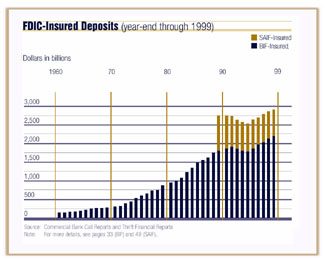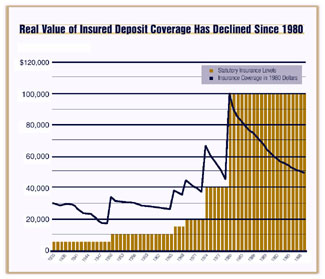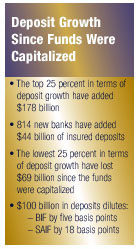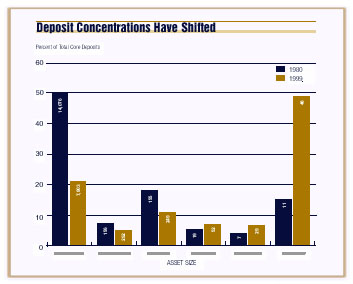Standing between the FDIC and the risks we have described is an array of private sector
and supervisory risk controls. By the end of the 1990s, it was clear that these
risk-mitigating tools were undergoing significant change. There was substantial discussion
about the implications of these trends for capital regulation, but discussions about the
implications for deposit insurance were in their infancy.Private sector risk management
strategies evolved considerably during the 1990s. An ongoing dialogue that included the
accounting profession, the financial regulatory community, and leading financial
institution practitioners resulted in a significant increase in the degree to which best
practices in risk management were formalized and made available. Quantitative tools to
measure and monitor risk became more sophisticated as well. Asset-liability management
software to assist in the evaluation and control of interest rate risk is now readily
available to financial institutions; market risks are being measured in real time through
value-at-risk models and other approaches; and credit risk modeling and measurement is
becoming more rigorous. As the decade closed, the risks identified through these tools
were being managed with financial instruments and financial technologies that did not
exist twenty years earlier.
Bank supervisors have long emphasized that the successful management of bank risk is
ultimately a function of the stewardship provided by bank management. During the 1990s,
the operational and policy implications of this philosophy began to be explored more
fully.
Supervisors placed more emphasis on
risk-focused loan review and transaction testing for the purpose of validating policies
and procedures, with more detailed testing where there was evidence of a need for further
review. In the arena of large or publicly traded banks, there was a clear policy momentum
towards improving the quality of management’s public disclosures, in order to enhance
the potential risk-mitigating effects of private market discipline.
The impact of these trends in risk management on
the FDIC’s losses will depend on the frequency of instances where specific aspects of
risk control systems do not work as intended. Thus, we should be concerned with any
systemic trend that increases the likelihood of such breakdowns. For example, we have seen
some cases where the opportunities to generate revenue inherent in a long expansion –
and the competitive pressures to do so – have led banks to compromise or neglect
important aspects of risk-management discipline. Warnings from the Securities and Exchange
Commission about the danger that some accounting firms may be compromising their
auditing business in favor of more lucrative consulting opportunities may provide another
example of a systemic trend towards an increasing volatility of risk-management outcomes.
Given these trends, it can be expected that the FDIC’s pricing and evaluation of risk
will, over time, continue to place heavy emphasis on identifying the quality of
banks’ risk controls.
| Risk-Related Premiums |
| The following tables
show the number and percentage of institutions insured by the Bank Insurance Fund (BIF)
and the Savings Association Insurance Fund (SAIF), according to risk classifications
effective for the first semiannual assessment period of 2000. Each institution is
categorized based on its capitalization and a supervisory subgroup rating (A, B, or C),
which is generally determined by on-site examinations. Assessment rates are basis points,
cents per $100 of assessable deposits, per year. |
| BIF Supervisory Subgroupsl |
|
A |
|
B |
|
C |
| Well
Capitalized: |
|
Assessment Rate |
0 |
|
3 |
|
17 |
|
Number of Institutions |
8,291
(93.7%) |
|
329
(3.7%) |
|
50 (0.6%) |
| Adequately
Capitalized: |
|
|
|
|
|
|
Assessment Rate |
3 |
|
10 |
|
24 |
|
Number of Institutions |
150
(1.7%) |
|
12 (0.1%) |
|
10 (0.1%) |
| Undercapitalized: |
|
|
|
|
|
|
Assessment Rate |
10 |
|
24 |
|
27 |
|
Number of Institutions |
2 (0.0%) |
|
0 (0.0%) |
|
8 (0.1%) |
|
| SAIF Supervisory Subgroupsn |
| Well
Capitalized: |
|
|
|
|
|
|
Assessment Rate |
0 |
|
3 |
|
17 |
|
Number of Institutions |
1,271
(91.6%) |
|
77 (5.5%) |
|
6 (0.4%) |
| Adequately
Capitalized: |
|
|
|
|
|
|
Assessment Rate |
3 |
|
10 |
|
24 |
|
Number of Institutions |
21 (1.5%)
|
|
5 (0.4%) |
|
7 (0.5%) |
| Undercapitalized: |
|
|
|
|
|
|
Assessment Rate |
10 |
|
24 |
|
27 |
|
Number of Institutions |
0 (0.0%) |
|
0 (0.0%) |
|
1 (0.1%) |
| l BIF data exclude SAIF-member "Oakar"
institutions that hold BIF-insured deposits. The assessment rate reflects the rate for
BIF-assessable deposits, which remained the same throughout 1999.
n SAIF
data exclude BIF-member "Oakar" institutions that hold SAIF-insured deposits.
The assessment rate reflects the rate for SAIF-assessable deposits, which remained the
same throughout 1999. |
|
|
A
New Legislative Framework  |
By a combination of legislative changes, regulatory choices and economic events, the
funding and pricing of FDIC insurance evolved during the 1980s and 1990s into something
fundamentally different from what existed during the first 50 years of the FDIC’s
history. The banking crisis of the 1980s led to two major pieces of legislation, the
Financial Institutions Reform, Recovery, and Enforcement Act of 1989 (FIRREA) and the FDIC
Improvement Act of 1991 (FDICIA). These laws have significantly changed the way the FDIC
conducts business in a number of areas, including the institutions it insures, the
insurance funds it administers, its enforcement powers, and the manner in which it
resolves failing institutions. Most noteworthy for the purposes of this article are two
requirements laid down by FDICIA: i) that the FDIC price insurance according to the risks
posed by individual institutions, in order to mitigate the moral hazard problems that can
attend any deposit insurance system; and ii) that it maintain the funds at designated
reserve ratios. The FDIC implemented its
risk-based deposit insurance premium system in 1993, the Bank Insurance Fund achieved its
designated reserve ratio in 1995, and it quickly became apparent that there were severe
tensions between a requirement for risk-based pricing and a requirement to manage the
insurance funds to a specific size. Implicit constraints on the size of the FDIC’s
insurance funds placed constraints on deposit insurance pricing at the individual
institution level. The tension between the twin requirements of risk-based pricing and
management of fund size became far more explicit in 1996, when the Deposit Insurance Funds
Act constrained both the FDIC’s ability to determine which insured institutions
belong in the best category for insurance purposes, and the premiums it can charge those
institutions.
In particular, when the insurance fund is above its
Designated Reserve Ratio (1.25 percent of insured deposits at year-end 1999), the FDIC in
effect cannot collect assessment revenue from institutions in its best insurance category,
which at year-end 1999 comprised 93 percent of all insured institutions. Conversely, when
the fund is below its designated ratio, the FDIC must collect sufficient assessment
revenue to return the fund to that Designated Reserve Ratio within one year, or else
collect average deposit insurance premiums of at least 23 basis points of domestic
deposits.
The new legislative and regulatory framework has resulted
in at least three striking departures from past practice. First is the zero
deposit-insurance premium paid by most banks. In contrast to the period 1933-1995, when
the FDIC assessed every dollar of domestic deposits at a rate of at least three basis
points per annum, after 1995 most deposits were not assessed at all. A striking feature of
a zero premium is that not only may the rate paid by vastly disparate banks be identical,
but the dollar amount as well: a bank with $100 billion in deposits can be billed the same
amount for its insurance as the smallest community bank.
Second, in reaching a point where the FDIC does not
collect assessment revenue from most institutions during good times, we have clearly
departed from any concept of spreading insurance losses over time. In contrast, prior to
1989 it could be argued that Congress intended the FDIC to operate under a form of
long-term expected loss pricing. During the period 1933-1989, when premiums were set by
statute and never departed from a range of between three and 8.9 basis points per annum,
accumulated premiums and the investment income on those balances enabled the system to
roughly pay for itself. The system in place today, in contrast, amounts essentially to
charging nothing in times of prosperity and a lot in times of adversity, thereby
potentially magnifying swings in the banking cycle.
A third change stems from the conjunction of two factors:
the FDIC’s original decision to rely on examination ratings as a significant input to
the risk based premium system, and the assessment revenue constraints of the 1996 Deposit
Insurance Funds Act. The banks that were paying for deposit insurance at the end of the
1990s were those that had run afoul of capital regulations or the supervisory process.
Thus, another departure from past practice was that the pricing of deposit insurance at
the individual institution level had evolved into a penalty system for the few, rather
than a priced service for all.
|
Issues
for Deposit Insurance Fund Management  |
From the FDIC’s standpoint, it was clear as the nineties drew to a close that the
terms of the tradeoff between the ability to price deposit insurance based on risk and
constraints on aggregate revenue needed to be re-evaluated. That tradeoff had been
resolved by the Deposit Insurance Funds Act in favor of a zero premium for most
institutions. As a result, by the end of the 1990s, the moral hazard problems FDICIA
intended to address through risk-based deposit insurance premiums may have become more
firmly entrenched than ever. At year-end 1999, the FDIC provided a non-priced guarantee of
over two trillion dollars in bank liabilities.Under
pure risk-based pricing, it is likely that every bank in the U.S. with insured deposits
would pay something for its deposit insurance, for the same reason that every bank pays at
least some spread over Treasuries for unsecured debt. Given the long and uncertain
duration of banking cycles, however, under such a system it would never be clear in
advance whether the premiums accumulated during times of prosperity were more, or less,
than what would ultimately be needed during periods of economic upheaval. Consequently,
there will inevitably be questions about the appropriate disposition of these accumulated
funds. The answer to such questions depends on one’s vision of how the costs and
benefits of the deposit insurance system should be shared.
Under one extreme, deposit insurance could be
viewed as completely private. Under this pure mutual model, monies collected by the
insurer are the collective property of the banks that contributed, any insurance losses
are their sole responsibility, and pricing of deposit insurance is not the subject for
public policy discussions but is of concern only to the banking industry. The history of
banking and financial crises in both the U.S. and other countries provides numerous
examples where bank losses were so severe and so systemic that the government was forced
to step in, either through loans or taxpayer bailouts. This experience calls into question
whether pure private deposit insurance would be economically viable over long periods of
time. |
|
BIF Report
SAIF Report
 
|
|
Another endpoint, in
which the mutual aspect of insurance is removed completely, might be termed the user-fee
or priced service model of deposit insurance. The insurer collects premiums on an
expected-loss or risk-adjusted basis from each institution. The premium is simply a
payment for a service, namely the use of the deposit guarantee for a specified time. In
this "demutualized" model, the premium payer has neither an ownership interest
in collected premiums nor a responsibility to pay for the insurance losses of other banks.
An insurance fund to provide rapid resolution flexibility is consistent with this model,
provided government reaps all surplus funds during good times and readily recapitalizes it
to cover all insurance losses. The pure priced
service model, taken to its logical extreme, makes moot a number of issues raised in this
article. Concentrations of deposit insurance exposure – although an issue for the
government insurer and its ability to diversify risks – are not an issue for insured
institutions because they are never asked to help pay for the failures of other banks.
Rebates from the insurance funds are ruled out, but conversely banks are relieved of the
responsibility to rebuild a fund during periods of economic hardship.
|
| Whereas history casts doubt
on the long-term economic viability of a pure private deposit insurance model, it also
casts doubt on the long-term political sustainability of a pure user-fee model. It is
human nature to keep score. As assessment revenues mount far above cumulative insurance
losses during good times, bankers will point out that the
costs of the system appear to be outstripping its benefits, and they will be heard, as
they were heard in 1950 when Congress required the FDIC to institute rebates of excess
assessment revenues, and again in 1996 with the Deposit Insurance Funds Act. Conversely,
during bad times Congress is unlikely to sit by while losses mount, under the theory that
everything will even out in the end. Instead, as they have in the past, the banking
industry probably would be asked to pay for as significant a share of losses as possible
before recourse is had to the taxpayer. |
| Between the two
endpoints of a purely private system and a pure user fee system – between a pure
mutual system and a completely demutualized one – are the intermediate models of
mutual insurance with a federal backstop against catastrophic loss. Under these
approaches, banks are mutually obligated to pay aggregate insurance losses up to a point,
and mutually entitled to some of the benefits of favorable fund performance. Under any
such approach, the federal government’s guarantee against catastrophic loss gives it
a significant public policy stake in ensuring that the guarantee is appropriately priced.
At the same time, all participants in the system have a significant stake in the manner in
which aggregate system performance results in shared costs and shared benefits. For example, under the current system, banks are mutually
obligated to recapitalize the insurance funds if the funds fall below a designated ratio;
conversely, when the funds remain above the designated ratio they are mutually entitled to
a benefit, namely zero-cost federal deposit insurance for most institutions. This
particular set of mutual obligations and benefits carries with it all of the issues we
described: the zero premium during good times; a |
|
 |
| potentially
heavy assessment during bad times; and a growing concentration of contingent deposit
insurance exposures. Current arrangements also create an issue we have so far deferred:
the tendency of a zero premium under a mutual insurance arrangement to create free-rider
problems, in which new banks, fast growing banks and non-banks can, at no cost to
themselves, increase the mutually shared obligations or reduce the mutually shared
benefits of other members of the system. There may be other quasi-mutual models where the rules for doling
out mutual costs and benefits are different than in our current system, and that do not
create the degree of perverse or unintended consequences as our current system. For
example, it is not clear that the shared benefit that accrues to the banking industry
during good times should necessarily be in the form of a zero deposit insurance premium.
One could imagine, for example, that premiums collected during good times could go first
to the insurance fund, and then to some asset in which member banks have a collective or
individual interest. There are many ways banks’ collective interest in such an asset
could be structured – through a rebate system, through a credit-union approach in
which each bank carries its share of the asset on its books, or some other approach in
which the collective asset only generates cash flows for banks during bad times. Under any
of these approaches, if ownership of the collective asset were apportioned analogous to a
mutual fund, with a dollar of premiums buying a dollar of shares, the free-rider problems
described above could be mitigated.
|
Implications
for Deposit Insurance Pricing  |
Risk-based deposit insurance pricing at the
individual institution level has two goals: to provide beneficial incentives to control
excessive risk taking and mitigate the moral hazard problems associated with flat-rate
deposit insurance; and to lessen the degree to which strong institutions subsidize weak
and poorly managed institutions, so that the cost of the insurance program is shared in an
equitable manner.
An interesting question is whether deposit insurance
pricing is conceptually redundant with supervision as a policy instrument to accomplish
these goals. There are reasons to think not. There are built-in limits in a market economy
on the degree that supervisors can or should attempt to control individual institution
behavior. To use a private insurance analogy, a supervisor is unlikely to take away
someone’s driver’s license simply because that person owns a sports car; an
insurer, without trying to change the behavior, can price it. Even under a theoretically
perfect supervisory capital regime where all institutions have an identical estimated
probability of failure, market pricing or other indicators may at times suggest that the
risk profiles of some institutions are significantly different than others. In such
instances deposit insurance pricing can be a policy tool that complements the tools
available to supervisors.
In practice, there are limits to what deposit insurance
pricing can and should try to achieve. The FDIC provides a monopoly-priced service, and it
may be undesirable for a federal agency to make exceedingly fine subjective distinctions
that have the effect of allocating credit to favored activities or institutions. Within
those limits, however, risk differentiation is important, and the technical issues of how
best to achieve it are significant.
PDF version of chart (39Kb PDF file - PDF help or hard copy)
 |
|
If a significant adverse change in the banking and economic cycle
occurs in the next few years, historical experience suggests that many of the resulting
bank failures will come from institutions that did not pay insurance premiums at year-end
1999. The question will then be how many of those premium misclassifications were the
result of what one might call random errors – the price we willingly accepted for not
having an overly burdensome regulatory and supervisory structure – and how many were
the result of systematically subsidizing certain types of riskier institutions at the
expense of other members of the system. |
| When we consider the more than 9,500 insured
institutions that all paid no premium at year-end 1999, there clearly were some systematic
factors that distinguished their risk profiles. The distinction between banks with
composite examination ratings of 1 and 2 is one example, but there may be others. For
example, should new banks or fast growing banks pay additional premiums, both for reasons of risk differentiation and to force
them to pay for the external cost they impose on other members in a mutual structure? Are
there indicators that would identify those banks within the best risk-related premium
category that have high concentrations of risky assets, significant interest-rate risk or
market risk, or weak risk-management practices? The best risk indicators may not be the same for large
institutions as for small institutions, and indeed, both onsite and offsite examination
procedures vary depending on the size, complexity and risk profile of a bank. FDICIA
provided the FDIC with authority to establish separate premium systems for large versus
small institutions. Because of their size, scope and complexity, large institutions and
their supervisors necessarily measure and manage risk differently than is the case for a
typical small bank. By the end of the nineties it was clear that some thought needed to be
given to the implications of the developments in large-bank risk measurement for the way
the FDIC measures risk for insurance purposes, so that the FDIC might benefit from the
results of risk measurement undertaken by industry practitioners, as well as by their
supervisors and publicly available sources. Likewise, risks taken by large banks are
priced in a variety of markets, conceivably resulting in useful information that may be
valuable in pricing deposit insurance. And the proliferation of financial instruments by
which risks are transferred and priced is at least suggestive of the possibility that new
instruments could be developed that could enhance risk-based pricing at the individual
institution level, or provide market signals about the direction of the FDIC’s
aggregate exposure.
Given the potential for a bank’s risk profile
to change quickly, changes in risk profiles in the interval between examinations may take
on added significance in the years ahead. The FDIC already has a number of offsite tools
for evaluating these inter-examination trends, and the importance of continuing to refine
such tools and develop new ones is likely to increase.
Finally, if risks are indeed becoming more opaque and
complex to monitor as we have argued, there is room for discussion of the implications for
deposit insurance pricing. An interesting public policy question is what role, if any,
deposit insurance premiums should have in providing incentives to banks regarding the
quality of their disclosures about the risks they undertake.
|
Insurance Coverage  |
There has been considerable discussion since
year-end 1999 about whether and how deposit insurance coverage should be adjusted for
inflation. The merits of indexing coverage ultimately depend on one’s view of the
role of deposit insurance in the financial system. Deposit insurance was implemented not
only to protect small savers, but to correct a market failure: the susceptibility of banks
to deposit runs, a susceptibility that arises from banks’ combination of illiquid
assets and liquid liabilities.
There was always a danger that deposit insurance would
simply replace one ill with another. While deposit runs are a thing of the past, in their
place we have a greater potential for the distortions and moral hazard problems that come
with a federal safety net. For those who do not think this has been a good tradeoff, the
policy prescription is clear: allow the deposit insurance coverage limit to erode in real
terms over time.
On the other side of the debate are those who point to
the array of private sector and supervisory risk mitigation tools, and more recently,
risk-based premiums, that can act as a counterweight to the potential moral hazard
problems. In this view, the increased stability deposit insurance brings is not completely
offset by other problems. There is also the view that every country has deposit insurance
– whether it knows it or not – and that meaningful, explicit coverage results in
lower costs in the event of banking crises than would occur under negligible or implicit
coverage. The argument is that little or no formal coverage may well turn into unlimited
coverage in times of crisis, while a meaningful and explicit coverage limit is more likely
to be adhered to. Proponents of this view would be more likely to recommend a coverage
limit that adjusts over time to maintain the same relative importance in the financial
system.
* * *
None of the issues discussed in this article are easy to
address, but their importance is undeniable. The time appears ripe for a productive debate
on how the U.S. deposit insurance system should be strengthened to meet the new
challenges.
|